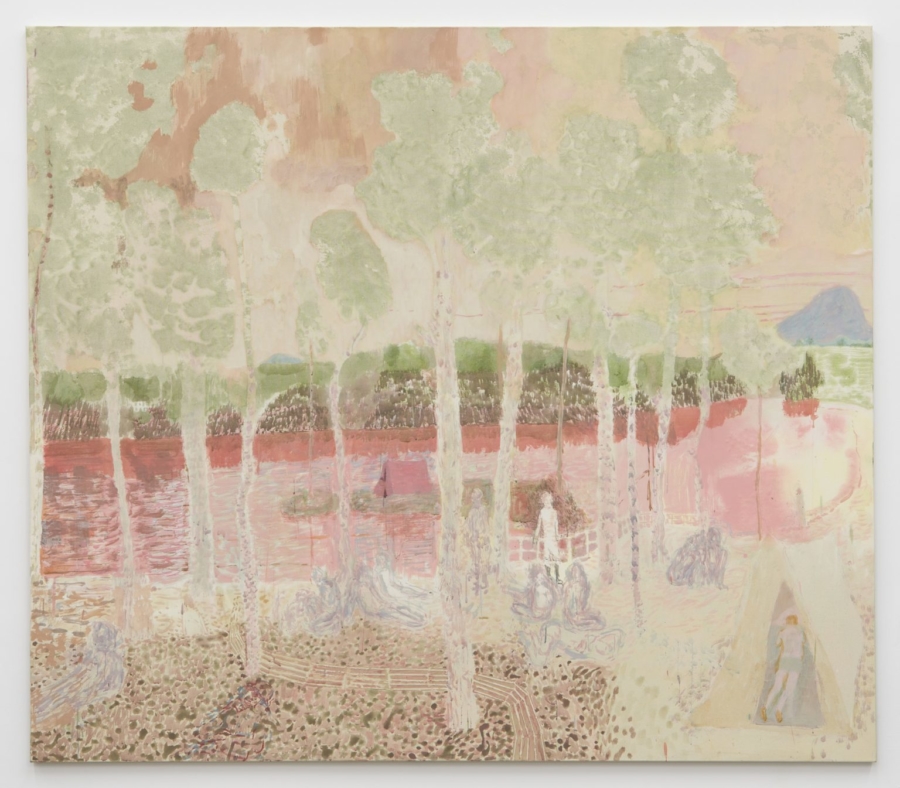
Andrew Cranston, “Deja vu,” 2021, rabbit skin glue and pigment on canvas, 78¾ × 90½ inches; 200 × 230 cm
I try not to go to galleries alone. If I don’t have someone to moderate me and make sure that I spend an appropriate amount of time viewing work, I can speed through without sufficiently absorbing it, to my own detriment. Yet, even on my own, I was immediately captivated by Andrew Cranston’s deceptively quiet, soft paintings in his current show “Waiting for the Bell” at Karma.
Cranston is equally comfortable with a quiet interior involving people enjoying pets and a beach hosting a sporting event. Both are mere splotches of paint, just representational enough for us to get the idea. Subject matter is secondary to Cranston’s formal concerns. He is too preoccupied with the way an image is constructed and executed to expend undue energy on narrative. But he does not forsake emotional content: the images have an oddly sweet atmosphere that is a touch melancholic, evoking a return to your hometown after everyone you knew has moved on. It’s familiar, but in his hands still different.
Cranston’s Déjà vu quotes Monet’s The Four Trees, filtering the reference through 100 years and making it feel fresh. Canvas-colored trees divide the red river that flows quietly behind the campers of the lower third of the picture, barely visible. The foliage is a bleached green plume that stands against the reddish sky. They feel polite, neither impinging on other. Against a warm orange ground, the campers are a pale, cool lavender, like children’s lips after they’ve spent all day in the pool. It was fun in the heat of the day, but now the temperature is dropping and it’s time to go home. There is no definitive focal point. Every object sinks into its surroundings. A painting that initially appears subdued becomes immersive. Instead of latching onto something specific, you amble through the picture, quietly consuming tiny morsels. The more that you look, the more you see counter-intuitive features. The trees should be freestanding, stable elements, but instead they’re defined only by what’s around them. The most literally fluid part of the painting – the river – is the most well-defined. Cranston also strikes an affecting tension between paint application and the bleaching of the canvas – that is, between adding and eating away.
In Waiting for the Bell, the title piece, an older woman sits in the center of the canvas as bleach explodes around her. Cranston clearly planned this painting carefully, exposing sections of the canvas to bleach for different amounts of time. The technique seems broadly reminiscent of using an acid bath to etch a copper plate. The effect is dazzling, making Cranston seem like a subtractive Bonnard. As before, Cranston is pitting one material against the other. The bleach is winning, but paint is valiantly seeking parity. Amid all this, the woman seems a rebellious but futile volley of pigment.
About half of the paintings in the show are on book covers. They can be more challenging to look at than the larger pieces. With less room to spread out, the tension can’t dissipate, so they vibrate on the wall. In general form, they tilt towards still lives and moments of adventure. A favorite of mine is One day this will be a long time ago. A pink and orange figure stands at middle distance. Our view is distorted, possibly from the heat radiating from the ground. A man to the right is in a tent, outside of which there are two pans, one containing eggs sunny-side-up. Cranston may be contemplating the extreme weather that we can expect to become the norm. The subject of the book whose spine he has appropriated is the New York draft riots of 1863. The color of the cover nearly matches the yellow of the painting, so that subject may be merely incidental to an aesthetic decision. But Cranston might also be referencing the possibility of civil unrest in response to unpopular but necessary government measures.
Another strong painting is Ayrshire shapes. Cranston’s paint-handling suggests we are viewing it in the reflection of a puddle. Most of the picture plane is taken up by a large cloud that hangs above a landscape consisting of a strip of ground and what looks like the ocean stretching behind the two heads gently poking over the earth. The cloud ripples. Hardly any paint is used, and when it is, it’s devoted to that cloud and a smaller one, which seem in opposition, keeping each other in check. Traces of heat on the cheeks of the people keep the painting from seeming frigid. Again, the specificity of color is intriguingly at odds with the painter’s broader reluctance to provide information.
Andrew Cranston’s show masterfully compels slow absorption and rewards the viewer for taking the time. His work is a counterpoint to brash, loud contemporary painting that draws people in with a quick, transient hit. He turns the screws slowly and quietly, wisely enforcing our patience.
“Andrew Cranston: Waiting for the Bell,” Karma, 188 and 172 E. 2nd Street, New York, NY. Through August 6, 2021.



